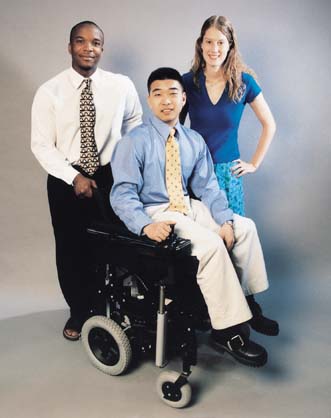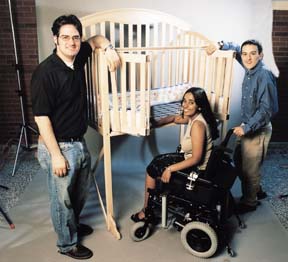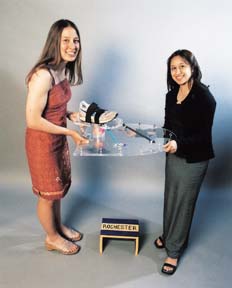
|
![[NEWS AND FACTS BANNER]](/URClipArt/misc/newsfacts.jpg) |
||||||||||

Engineering for the 21st CenturyRochester undergraduates are flocking to study the connections between engineering and the biological studies, making biomedical engineering one of the fastest growing majors on campus. Putting their newfound knowledge to the test, students in the senior design course develop medical and rehabilitation devices - projects that meld science, engineering, business, and a lot of old-fashioned elbow grease. By Scott Hauser
Suzanne Ferreri '01 woke up one spring morning with an idea. She and her senior teammates Temi Sodunke and Timothy Salmon had been working all semester to design a new device that would help stroke patients and others retrain atrophied muscles in their arms.
The device had to allow a range of motion yet be sturdy enough that physical therapists could lock it into position for certain exercises. But the three members of the biomedical engineering senior design course had
been struggling over plans for a joint that would allow the arm cuff to rotate
properly. What if the arm cuff rested on a small block of aluminum carefully machined with a narrow split so that a system of screws could tighten it into place? Some time in the lab, a little more in the machine shop, and a "wheelchair-mounted, balanced forearm orthosis" was born. "We did a little engineering and used a little creativity and came up with this," is how Ferreri describes the trial-and-error process. The device, which looks a little like a high-tech arm rest attached to the wheelchair by slender aluminum tubing, was formally presented to the Occupational Therapy Program at Strong Memorial Hospital in early May. A project for the capstone class of Rochester's recently launched undergraduate program in biomedical engineering, the device was not just homework for its designers. Thoughts of developing a better biomedical mousetrap, so to speak, had spilled beyond the two hours a week that the course met, and well beyond the more than 10 hours a week that each team member spent in the basement lab in Gavett Hall or working independently. This was the realm of "Eureka!" But the process-designing, developing, and producing a piece of medical hardware that will improve the lives of patients -is, at heart, what appeals to undergraduates studying one of Rochester's newest and hottest majors.
As its name implies, biomedical engineering emphasizes the interaction between engineering-along with its strengths in problem-solving, design, mathematical and computer modeling-and the biological sciences. All with the goal of improving human health. "This is a great 21st-century major," says Kevin Parker, dean of the School of Engineering and Applied Sciences. "And it's part of our destiny. We have a strong history of collaboration between the engineering school and the Medical Center that gives us a nucleus around which to build a really topflight undergraduate program." While Rochester has a 40-year history as a leader in many of the fields associated with biomedical engineering, the College joins a growing number of universities in the United States offering degrees in the subject. Introduced in 1997 as interdisciplinary degree programs at the bachelor's, master's, and doctoral levels, and formally established as a full department in 2000, biomedical engineering has seen undergraduate enrollment grow from a handful of students three years ago to about 160 majors last spring. The skyrocketing trend mirrors national figures, which show overall enrollment in engineering programs holding steady while enrollment in biomedical engineering shoots skyward. According to the Whitaker Foundation, the nation's leading nonprofit foundation dedicated to supporting biomedical engineering, there were 85 universities in the United States that offered a biomedical engineering program, including 48 at the bachelor's level, in 2000. That's up from 1994, when 43 universities had programs, including 25 at the bachelor's level. "Students are lining up at our doors," John Linehan, vice president of the foundation, told a gathering of biomedical engineering educators last December. Not that those doors haven't been open for a long time. The foundation's records show that the first formal program at the doctoral level in biomedical engineering was established in 1961 at Johns Hopkins University. The University of Illinois at Chicago gets credit for the first undergraduate program in 1965. Also in the early 1960s, Rochester was among the first recipients of National Institutes of Health grants to study fields that today are considered central to biomedical engineering. Some of that work, involving electrical and computer engineers and medical scientists, evolved into the Rochester Center for Biomedical Ultrasound, one of the field's premier groups. The convergence of technological and biological discoveries of the past decade -think of cloning or the sequencing of the human genome-has put the spotlight on biomedical engineering. And rekindled student interest. "These are areas where engineers are poised to make a contribution," says Richard Waugh, chairman of the Department of Biomedical Engineering. "This is clearly the new, emerging area of engineering." And it has required some new-at least for a university-working relationships. Biomedical engineering is the only academic department that has a solid footing on both the River Campus and the Medical Center. Even the faculty appointments are split down the middle: Of the eight faculty in the department, four have primary appointments in the School of Engineering and Applied Sciences and four have primary appointments at the Medical Center. That intercampus mindset is necessary to create the best biomedical engineering programs, says Waugh, who has a secondary appointment as a professor of pharmacology and physiology at the Medical Center. "Students can walk across Elmwood Avenue to meet with faculty who are putting into practice many of the ideas they are learning in classrooms and laboratories," he says. "We can bring into classrooms faculty who are at the frontlines of their disciplines." The intellectual exchange between medical scientists, professionals, and engineers also intrigues students. "This was a really cool opportunity to talk to doctors and see what they needed," says Salmon about working on the wheelchair arm device. "The doctor says, 'Here's what I need it to do,' and then we try to come up with a device that does it." Puthiery Va '01, who, with her teammate Andrew Locke '01, designed and built revolving shelves for a refrigerator that can be used by a wheelchair-bound person, agrees. "You get a well-rounded view," she says. "You see things from the patient's point-of-view and you see how doctors work with the devices." The interaction is a key component of the senior design class. Taught by Jack Mottley, associate professor of electrical engineering, the class is organized something like a collection of small, technologically based, medical device startup companies. During the fall semester, students take an optional two-credit course in which they come up with an idea for a project. For the 2000-01 year, the focus was on devices to help the physically disabled. To help with research, Mottley and the students tour facilities such as occupational therapy at Strong and the Mary Cariola Children's Center, a Rochester- based rehabilitation program. The students talk with therapists, residents, patients, and doctors to get a sense of what the people who will ultimately use the devices need from biotechnology. After deciding on a project, students hold a "job fair" at the end of the first semester to recruit team members from the senior class, all of whom must take the second-semester segment of the design course. During the spring semester, students conduct research (including questions of patentability and marketability), design, and try to build a version of their devices. The 2001 course included projects that are research-oriented-for example, Kareen Kreutziger '01 developed a computer simulation of the early formation of an embryonic chicken heart-but most of the projects resulted in a device. Among those devices was a hydraulic lift system for a wheelchair designed by seniors Curtis Evrard, John Choi, and Jaclyn Zbrezny that allows people in chairs to raise themselves to areas that are sometimes inaccessible to them. "Instead of having to change your environment to make it accessible, we tried to make our chair accommodate the different environments that people would be in," Evrard says. The chair's six-inch reach can mean the difference for a wheelchair user of seeing his face in the bathroom mirror in the morning, Evrard notes. Other projects included a redesigned baby crib for a mother who suffered a spinal cord injury; a system that uses radio frequency technology-similar to that used in garage door openers-to help visually impaired people navigate campus; an electronic sensor device to help woman athletes improve their jumping techniques to avoid anterior cruciate ligament injuries; and a device to help athletes rehabilitate from ankle injuries. By semester's end, nearly all the inventors have a working prototype, but some projects, the designers admit, need a little more tweaking. "Companies in America have difficulty in launching a product in two years so I don't expect them to accomplish that in a semester," Mottley says. "Even a full academic year is not enough time to do that." He sees himself as a coach to the students, who, by their senior year, have a firm understanding of the engineering and life sciences basics. Although the students may not realize it. "The role of a coach is to remind you of things that you already know," Mottley says. Much of that discovery comes from hours spent in the lab in Gavett Hall. And hours. And hours. "Near the end we've all been living in the lab," says Erika Mazza '01, who, along with senior teammates Christina Lee, Mu Hua Pang, Brian Curran, and Mahbubul Haque, developed the navigation system for the visually impaired. "But it's worth it in terms of what we are working toward-to be able to help someone," she says. "We all hope that it will be used." Each student receives a $500 budget paid out of student fees and grant money from the Whitaker Foundation to buy parts and to pay for other work needed for the projects. And the parts pile up. The basement lab houses a collection of electronic odds and ends-capacitors, circuit boards, black transponder discs stacked like space age coasters-as well as low-tech gadgetry of saws and sandpaper, parts guides, and diagrams. Linda Pazral '01 and Ronald Alonzo '02 poked through an International Coffee cappuccino tin of wires and capacitors as they worked to design a circuit for the electronic sensor of "good" and "bad" jumps for woman athletes. Once they completed a circuit on a plastic "breadboard," they would send it to a company to manufacture a working circuit. Pazral, who came to Rochester planning to be an ophthalmologist, says she's always been fascinated by the engineering behind the medicine. "The doctors are the ones who try to cure you, but it's more interesting to develop the technology that the doctors rely on," Pazral says. The design class requires a little more creativity than other classes, students say, but that's what makes engineering worthwhile. "Basically, we have to read a manual for each component and figure out how it works ourselves," says Lee about working on the navigational system. "It's very interesting. And it's challenging, but that's what engineering is about." Mazza agrees. "It really brings together all the pieces that we have to learn," she says. "It's definitely taught me a lot." "We've done a lot of smaller projects, but we've never done a project
where we ended up with one product that works," Mazza says. "It's
been a yearlong process." Diane Dalecki '83, '94 (PhD), assistant professor of biomedical engineering and a freshman advisor for biomedical engineering, says most applications of the skills students are learning have yet to be thought of. Biomedical engineering takes biology where it exists now and technology where it exists now and takes them both further-which is exciting," Dalecki says. "It's a field that asks how life might be different in the future." Or as Alonzo puts it, as he and Pazral struggle to get the circuit for their project to work: "You never know what you are capable of." Scott Hauser is editor of Rochester Review. Maintained by University Public Relations | |||||||||||


